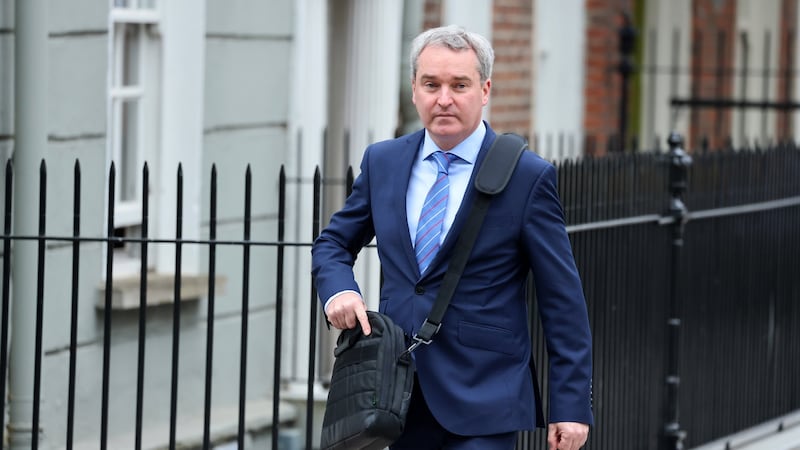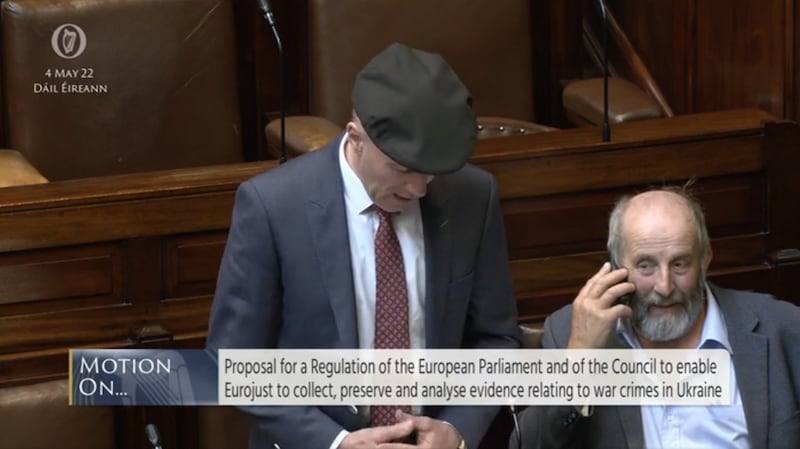There was a definite vibe of post-pandemic giddiness about the launch of Pandemonium, Jack Horgan-Jones and Hugh O’Connell’s forensic history of the pandemic in Ireland and racy account of what went on behind the scenes in the corridors of power during this turbulent period.
“Illuminates the corners of institutions usually able to operate in the dark,” according to Fintan O’Toole.
But never mind that. What about Robert Watt’s curtains? (And what did we ever do before the invention of the aforementioned Watt, the civil servant who’s never out of the news these days.)
It’s a testament to the research done by the co-authors that the silken backdrop favoured by one of the key participants during Covid crisis Zoom meetings made it into the pages of their fascinating analysis. But it wasn’t the prospect of more revelations about the soft furnishing choices of senior government mandarins that drew such a huge crowed to the Hodges Figgis bookshop on Dawson Street on Thursday evening.
No. It was the tantalising prospect of rows breaking out between the respective editorial camps of the two writers. Pandemonium is a collaboration between Horgan-Jones of The Irish Times and O’Connell of the Irish Independent. With free wine on offer and the promise of a knees-up afterwards in the nearby Duke pub, people were nursing high hopes of post-pandemic pandemonium breaking out between the rival hack factions before the end of the night.
The two political reporters first met while working in the Sunday Business Post and they have remained friends down through the years.
The seating arrangement in front of the microphones – two sections with a little aisle in the middle – made it look like a wedding, prompting one wag to wonder “if the children will be raised Catholic or Irish Times”.
Dara Calleary was in attendance, patiently smiling at all the quips about him attending a crowded function where nobody was wearing a surgical mask
Mercifully, the speeches were short. O’Connell said they set out to find what Woodward and Bernstein described as “the best obtainable version of the truth” of what happened during the period.
“Our job was to report on those taking the decisions that affected out lives,” he said, adding that there was lot of debate about leaks at the time “but leaks were ultimately essential to telling the story of what actually happened” in Ireland over the past two years.
They got hold of the angry memo sent to ministers by then Taoiseach Leo Varadkar after information was leaked to newspapers.
“Dear Colleague, I am writing to you to express my distress at the fact that one or more member of the cabinet told others about our discussion on physical distancing rules,” he began, reminding cabinet members in no uncertain terms of their duties and explaining at some length why leaking is so wrong and such a bad thing to do.
“I really hope this will be the last time this happens. There’s only a few weeks left in this government. Please let us finish well,” Leo concluded.
Because he was just plain Leo then. But by the end of the year Varadkar was being denounced in some quarters as “Leo the Leak” after walking himself into a controversy of his own making. And he isn’t out of the woods on that front yet.
Horgan-Jones said they “wanted to tell the story in as much detail as possible of an extraordinary time in Ireland, of an extraordinary time in Irish public life and of an extraordinary time in the lives of the Irish public”. It was “perhaps the most remarkable story we will ever cover”.
There were no Government Ministers at the launch, although former Fianna Fáil minister and Golfgate casualty Dara Calleary was in attendance, patiently smiling at all the quips about him attending a crowded function where nobody was wearing a surgical mask.
Prof Philip Nolan, erstwhile chair of Nphet’s epidemiological modelling group, was also among the crowd, and it wasn’t long before people were asking him to autograph their books. Which he did, writing “I wasn’t the source” before he signed.
Horgan-Jones spoke of the many, many interviews they carried out and some of the stranger nuggets they unearthed.

“Early on in the reporting process someone told us an anecdote about Robert Watt’s drapes – the curtains that were in the backdrop to his Zoom calls,” he recalled. “And I never thought I would spend quite so much time trying to stand up what our original source described as ‘the silk curtains’ before adding ‘It was kind of sultry’. Despite having a double source by the time we interviewed the Tánaiste, we nevertheless asked him about them as well, eliciting the unforgettable description from Leo Varadkar as ‘like something from a boudoir.’ ”
Both men put in long, intensive hours on the project, which they started in June last year, along with working their day jobs. Horgan-Jones told the crowd how, in the middle of writing their opus, his ever-patient wife, Kate, “turned to me, and looked me in the eye, and said earnestly, ‘Jack, I cannot wait to hold your book in my hands so I can shove it up your hole.’ ”
That got the biggest laugh of the night, which just about compensated for the sickening outbreak of camaraderie between the rival factions from the Indo and The Irish Times. This is what happens when the free wine runs out early.
Pandemonium: Power, Politics and Ireland's Pandemic is published by Gill Books, €16.99.
Battle of the badges
Once upon a time the only ironmongery found on a politician’s lapel was the Fáinne Nua, a pioneer pin and, in certain circles, an enamel Easter lily.
Not any more. It’s hard to keep up with the proliferation of badges, pins, ribbons, buttons and bows sported by our politicians these days. Commemorating this, marking that, fundraising for the other and standing in solidarity with people and nations.
The decade of centenaries has seen an explosion in the production of these little pieces of clothing furniture. Sinn Féin has been churning out the buttons and badges for decades. And now we see Fine Gael has launched two 1922-2022 commemorative pins (available for a limited period only), one featuring Michael Collins and the other featuring Arthur Griffith. A fiver each.
Meanwhile, events to mark the centenary of the Seanad are in full swing in Leinster House. On Thursday, “father of the house” Senator David Norris unveiled an exhibition in the foyer called Minority Voices, Major Changes, the first in a series of public exhibitions highlighting the life and work of Senators who have championed minority issues over the years.
As a proud member of the Upper House, Independent Senator Gerard Craughwell wanted to do his bit to mark the centenary. He took it upon himself – at his own expense – to commission commemorative pins for his Seanad colleagues. The first batch was left in pigeonholes earlier this week. The round pin displays the Houses of the Oireachtas logo (gold harp encircled by green lines on a white background) with “Seanad Éireann 100” written above it and the word “Member” written below it. “Member” presumably because it would have cost too much to put “Do You Not Know Who I Am?” in gold letters.
It’s a lovely little badge with a simple, traditional-looking design. Unfortunately, the original run had to be recalled because of a number of typographical errors. But big-hearted Gerry quickly issued replacements.


On Thursday, Mark Daly, the Cathaoirleach of the Upper House, issued his own official Seanad 100 commemorative badge. This is a far flashier affair, all gussied up in gold. It does not appear to denote membership of the most exclusive and feather-nested club in the country, but all Senators have been issued with one.
Which one will Senators chose to wear? Daly’s official one or Craughwell’s provisional one? This could turn into a contentious tit-for-tat turf war. Perhaps they will wear both, along with all the other other commemorative pins and ribbons for Ukraine and entwined enamel flags and fáinnes and favours and …
One amused staffer remarked: “If they get any more badges and buttons they’ll be like the pearly kings and queens.”
Phoning it in

Danny Healy-Rae’s mobile phone ringing at inappropriate times during Dáil sessions is almost an established feature of parliamentary engagement at this stage. Former Labour leader Alan Kelly famously lost his rag during Leaders’ Questions last year when Danny’s vintage Nokia blared out its familiar chimes yet again.
No amount of telling him to turn it off or put it on silent has worked.
“Is it ever going to stop, a Cheann Comhairle?” sighed Alan. “Every. Single. Day. Are you ever going to do anything about it? It’s just continuous.”
But Danny was unrepentant. “”Who’d want to ring you?” he retorted. “Because you’d do nothing for them anyway.”
While Michael was speaking in the debate, Danny dialled up somebody and listened for a while before whispering something like "We're on now!"
His brother Michael joined the attack.
“That’s your answer. There’s no one ringing you anyway, you do nothing for no one. You’re not doing anything for anyone,” he roared at Kelly. “Only here yapping. If you minded your own business you’d be a great man.”
Danny’s phone didn’t ring on Wednesday afternoon when Michael was on his feet beside him and speaking to a motion on the investigation of alleged war crimes in Ukraine. His mobile didn’t ring this time because he was the one making the call. In the chamber. During a sitting.
While Michael was speaking in the debate, Danny dialled up somebody and listened for a while before whispering something like “We’re on now!” He ended the call shortly afterwards and then turned in his seat and urgently whispered something to his brother, who was still speaking. Then Michael finished up abruptly and handed over to his colleague, Michael Collins.
All very mysterious.












